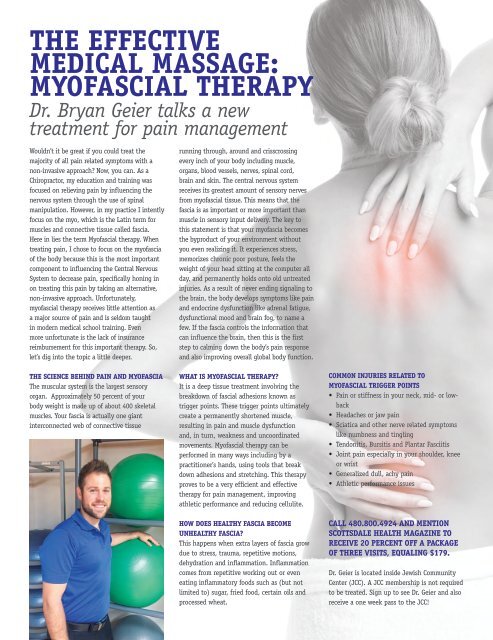Scottsdale Health June 2019
Create successful ePaper yourself
Turn your PDF publications into a flip-book with our unique Google optimized e-Paper software.
THE EFFECTIVE<br />
MEDICAL MASSAGE:<br />
MYOFASCIAL THERAPY<br />
Dr. Bryan Geier talks a new<br />
treatment for pain management<br />
Wouldn’t it be great if you could treat the<br />
majority of all pain related symptoms with a<br />
non-invasive approach? Now, you can. As a<br />
Chiropractor, my education and training was<br />
focused on relieving pain by influencing the<br />
nervous system through the use of spinal<br />
manipulation. However, in my practice I intently<br />
focus on the myo, which is the Latin term for<br />
muscles and connective tissue called fascia.<br />
Here in lies the term Myofascial therapy. When<br />
treating pain, I chose to focus on the myofascia<br />
of the body because this is the most important<br />
component to influencing the Central Nervous<br />
System to decrease pain, specifically honing in<br />
on treating this pain by taking an alternative,<br />
non-invasive approach. Unfortunately,<br />
myofascial therapy receives little attention as<br />
a major source of pain and is seldom taught<br />
in modern medical school training. Even<br />
more unfortunate is the lack of insurance<br />
reimbursement for this important therapy. So,<br />
let’s dig into the topic a little deeper.<br />
running through, around and crisscrossing<br />
every inch of your body including muscle,<br />
organs, blood vessels, nerves, spinal cord,<br />
brain and skin. The central nervous system<br />
receives its greatest amount of sensory nerves<br />
from myofascial tissue. This means that the<br />
fascia is as important or more important than<br />
muscle in sensory input delivery. The key to<br />
this statement is that your myofascia becomes<br />
the byproduct of your environment without<br />
you even realizing it. It experiences stress,<br />
memorizes chronic poor posture, feels the<br />
weight of your head sitting at the computer all<br />
day, and permanently holds onto old untreated<br />
injuries. As a result of never ending signaling to<br />
the brain, the body develops symptoms like pain<br />
and endocrine dysfunction like adrenal fatigue,<br />
dysfunctional mood and brain fog, to name a<br />
few. If the fascia controls the information that<br />
can influence the brain, then this is the first<br />
step to calming down the body’s pain response<br />
and also improving overall global body function.<br />
THE SCIENCE BEHIND PAIN AND MYOFASCIA<br />
The muscular system is the largest sensory<br />
organ. Approximately 50 percent of your<br />
body weight is made up of about 400 skeletal<br />
muscles. Your fascia is actually one giant<br />
interconnected web of connective tissue<br />
WHAT IS MYOFASCIAL THERAPY?<br />
It is a deep tissue treatment involving the<br />
breakdown of fascial adhesions known as<br />
trigger points. These trigger points ultimately<br />
create a permanently shortened muscle,<br />
resulting in pain and muscle dysfunction<br />
and, in turn, weakness and uncoordinated<br />
movements. Myofascial therapy can be<br />
performed in many ways including by a<br />
practitioner’s hands, using tools that break<br />
down adhesions and stretching. This therapy<br />
proves to be a very efficient and effective<br />
therapy for pain management, improving<br />
athletic performance and reducing cellulite.<br />
HOW DOES HEALTHY FASCIA BECOME<br />
UNHEALTHY FASCIA?<br />
This happens when extra layers of fascia grow<br />
due to stress, trauma, repetitive motions,<br />
dehydration and inflammation. Inflammation<br />
comes from repetitive working out or even<br />
eating inflammatory foods such as (but not<br />
limited to) sugar, fried food, certain oils and<br />
processed wheat.<br />
COMMON INJURIES RELATED TO<br />
MYOFASCIAL TRIGGER POINTS<br />
• Pain or stiffness in your neck, mid- or lowback<br />
• Headaches or jaw pain<br />
• Sciatica and other nerve related symptoms<br />
like numbness and tingling<br />
• Tendonitis, Bursitis and Plantar Fasciitis<br />
• Joint pain especially in your shoulder, knee<br />
or wrist<br />
• Generalized dull, achy pain<br />
• Athletic performance issues<br />
CALL 480.800.4924 AND MENTION<br />
SCOTTSDALE HEALTH MAGAZINE TO<br />
RECEIVE 20 PERCENT OFF A PACKAGE<br />
OF THREE VISITS, EQUALING $179.<br />
Dr. Geier is located inside Jewish Community<br />
Center (JCC). A JCC membership is not required<br />
to be treated. Sign up to see Dr. Geier and also<br />
receive a one week pass to the JCC!

















